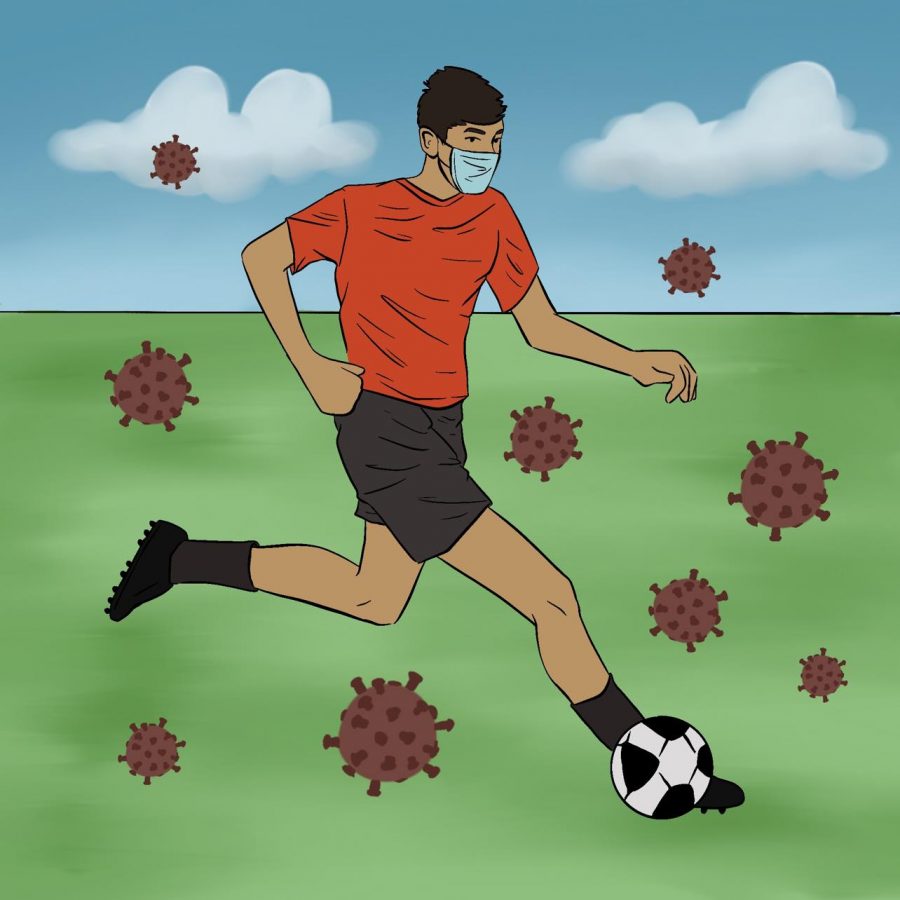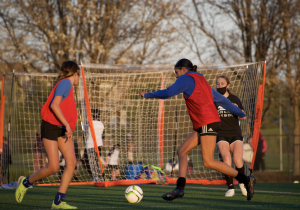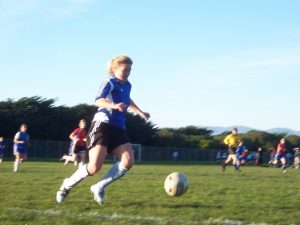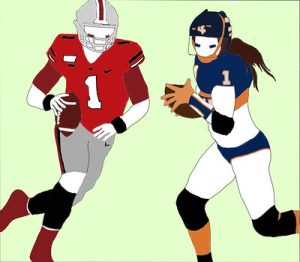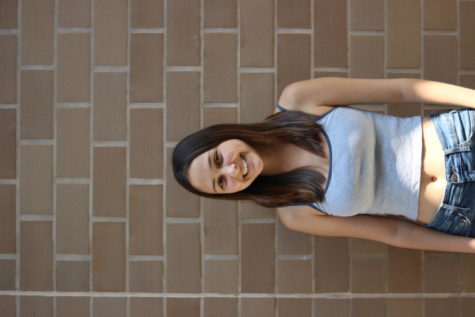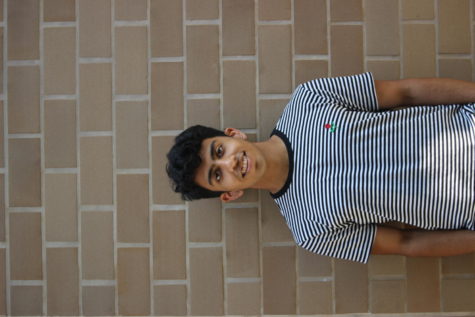Surf Cup Sports study on youth soccer during the pandemic raises questions about data collection integrity and implications
Athmika Sriram
A San Diego-based study on the risk of youth soccer during the pandemic is being debated over its methodology and impact.
May 12, 2021
A San Diego-based study conducted by Surf Cup Sports on the risk of COVID-19 transmission during youth soccer practices has gained attention— both critical and encouraging— in the national sports community over the past seven months, including in the Tri-Valley.
The study was spearheaded by renowned youth San Diego Surf Soccer Club (SD Surf) under its parent organization Surf Cup Sports. Over eight weeks, around 6,500 players and 263 coaches were observed from six clubs in San Diego county (SD Surf, Oceanside Breakers, Carlsbad City, Albion Soccer Club, Rebels Soccer Club and San Diego Soccer Club.) In over 143,000 training sessions, the study reports that “only 15 (.01%) confirmed cases were found.” All cases were transmitted outside of soccer sessions, the study determined.
When it was released last summer, Surf Cup Sports’ study was one of the only studies conducted directly by a soccer institution— let alone one of the few studies on youth soccer in general— that produced data on the safety of youth sports during the pandemic.
At the same time, youth soccer clubs were scrambling to draft original safety guidelines to get back on the field as soon as possible.
Because data on youth sports was, and still is, relatively scarce, many top clubs turned to Surf Cup sports’ whitepaper to incorporate research into their safety protocol.
But despite the study’s popularity in parts of the soccer community, it received criticism on several parts of its methodology and presentation.
Concerns surrounding the study’s credibility
CEO of Surf Cup Sports Brian Enge and “head” of the study acknowledged apprehension with the study himself.
“We had quite a few doctors and politicians in San Diego County criticize the study, and say ‘this isn’t conclusive evidence, you shouldn’t be making judgments based on this,’” he recalled.
Specifically, Enge cited the study’s self-reported nature of data collection as one of the main concerns of the medical community.
“Their (critics’) point was [that] people are self-reporting when they test positive, but no one’s stating if they are possibly asymptomatic. So their thought was, ‘you may have more cases than you think out on the field’, throwing off the ratio that we saw, which was incredibly low.”
An additional point of confusion with the study’s methodology was how it concluded that all positive cases detected were transmitted outside of soccer practice. This indicates that the club had some contact tracing occurring to determine this, but there is no explanation of how they accomplished this in the study.
“[I have] no idea how they came to this conclusion, which weakens the strength of their conclusion,” Boyd said, referring to the claims about transmission aforementioned.
Dan Chamberlain, executive director of SRFC, says that he can see why Surf Cup Sports was inclined to conclude that transmission was external.
“[I’ve seen] similar experiences across clubs where players test positive and there has not been any transmission at training that anyone can link to”, which may point towards soccer [being] safe,” he said.
However, he stressed that the study’s data should be “taken with a grain of salt” because of its lack of clarity around how contact tracing was performed.
Furthermore, there are no quotes or information explaining how Surf Cup Sports managed to obtain accurate COVID data without any apparent partnership with an unbiased third party (such as a hospital) to conduct the study.
Kevin Crow, Ballistic United Soccer Club’s executive director of technical director of playing and coaching development believes that collaboration with experts is necessary for a study like SD Surf’s to be taken seriously.
“If we (BUSC) were going to do a study like that, we would have included Boyd, [because] she works for Stanford Medical. We would make sure that experts in the medical field are the ones actually doing the study.”
Chamberlain echoed Crow’s sentiments, pointing to the necessity of including external actors to carry out an academically-sound research process.
“It is dangerous to grab anything that agrees with you without doing a lot of research. Surf definitely has a financial interest in reopening quickly,” he said. (Enge did admit that Surf Cup Sports lost 80% in total revenue leading up to the study, but refuted claims that the research was financially-motivated.) “That doesn’t mean they’re wrong, it just means that we need to be cognizant of the biases that things are coming from.”
Surf Cup Sports’ response to the controversy
Enge agreed that some of the criticism the study received was “fair”, such as the anxiety surrounding it’s self-reported nature and possible asymptomatic cases. However, other points of controversy did not go unaddressed.
Responding to concerns surrounding contact tracing, Josh Henderson, senior director of coaching at San Diego Surf, explained that the participating clubs in the study all had ways of confirming that transmission was indeed external.
If a player failed the required health check questionnaire, they would be instructed to get tested. Their team would suspend practice and the rest of the team would be scheduled to test 72 hours after the player in question did. If that player tested positive, the rest of the team would have to wait seven days before getting tested again. If all remaining players tested negative, practice would resume.
Henderson said that the 72 hour incubation period was to ensure that if a player was suspected of contracting COVID-19 through soccer practice, it would be able to be detected in other players on the team.
Out of all positive cases, Henderson confirmed that no other players tested positive after a positive case was determined on a specific team, leading to the study’s conclusion that all transmission was external.
In regards to the claim that the study lacked input from medical professionals, Enge said that this was not completely true.
“We actually have several doctors inside of families of our club. So we did reach out to them and procure as much information as possible about what was happening,” he explained.
Enge furthered that he proposed the original “scientific methodology” for the study, and the doctors were there to “ok” it.
As to why the club did not pursue more formal collaboration with the medical community, Enge indicated that multiple health institutions in the San Diego area were aware of the study in its initial stages, but were unwilling to support it. Regardless, Enge believes that their cooperation was not entirely necessary.
“It’s like we were sitting in the lab with the rats every day; there wasn’t much that a doctor or a scientist could really do to help.”
Reflecting on the study’s impact and future steps for Surf Cup Sports
Not only was the study influential in SD Surf’s reopening campaign, but it also impacted clubs right here in the Tri-Valley.
Executive Director Fred Wilson of Mustang Soccer in Danville was one of a handful of soccer directors nationwide that utilized the study’s results to guide reopening documents.
“In late August, I created a presentation for the state of California. It was right after the tiering system came out, and that white paper was there. [The study] was not empirical, [it] was just based on their own observations. The reason I used [the study] was to call for the state to do more empirical studies in terms of transmission of COVID,” Wilson said.
This presentation, along with others, has been distributed across clubs from southern California, Texas, and other regions nationwide.
The study also had other implications besides helping clubs advocate for a return to competition. Michael Higgins, general manager of West Coast FC and supporter of the study, explains that there are other factors like players’ mental health involved as well.
“I heard from several parents of high school players who caught their kids in the room by themselves crying [because] of the weight of everything that was going on,” Higgins said.
He stresses that “the fact that they are now back on the field, having social interaction, moving around and doing something healthy” is extremely positive. Higgins believes that the study was beneficial as it provided confirmation that costs of returning were significantly less than the mental health related implications of not going back.
As for Surf Cup Sports, the study was just that— a single study. According to Enge, the organization is not looking to conduct further research any time soon.
“We saw people at a more national level take it and run; we saw the Dutch Football Association doing a study and then we saw the Journal of Sports Medicine do a study. At that point, there were a lot more sophisticated groups to continue doing analysis than us.”
However, Enge by no means regrets leading the study. Months later, he still believes the results were crucial for the organization and the soccer community to breathe a sigh of relief.
“It was a way for us to derive confidence that we were keeping our kids safe.”


